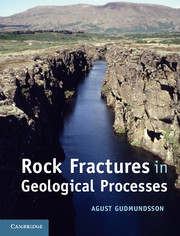Book contents
- Frontmatter
- Contents
- Preface
- Acknowledgements
- 1 Introduction
- 2 Stress
- 3 Displacement and strain
- 4 Relation between stress and strain
- 5 Loading of brittle rocks to failure
- 6 Stress concentration
- 7 Theories of brittle failure of rocks
- 8 Extension fractures and shear fractures
- 9 Displacements and driving stresses of fractures
- 10 Toughness and fracture mechanics
- 11 Field analysis of extension fractures
- 12 Field analysis of faults
- 13 Evolution of extension fractures
- 14 Evolution of faults
- 15 Fluid transport in rocks – the basics
- 16 Fluid transport in faults
- 17 Fluid transport in hydrofractures
- Appendix A Units, dimensions, and prefixes
- Appendix B The Greek alphabet
- Appendix C Some mathematical and physical constants
- Appendix D Elastic constants
- Appendix E Properties of some crustal materials
- Index
- References
5 - Loading of brittle rocks to failure
Published online by Cambridge University Press: 05 June 2012
- Frontmatter
- Contents
- Preface
- Acknowledgements
- 1 Introduction
- 2 Stress
- 3 Displacement and strain
- 4 Relation between stress and strain
- 5 Loading of brittle rocks to failure
- 6 Stress concentration
- 7 Theories of brittle failure of rocks
- 8 Extension fractures and shear fractures
- 9 Displacements and driving stresses of fractures
- 10 Toughness and fracture mechanics
- 11 Field analysis of extension fractures
- 12 Field analysis of faults
- 13 Evolution of extension fractures
- 14 Evolution of faults
- 15 Fluid transport in rocks – the basics
- 16 Fluid transport in faults
- 17 Fluid transport in hydrofractures
- Appendix A Units, dimensions, and prefixes
- Appendix B The Greek alphabet
- Appendix C Some mathematical and physical constants
- Appendix D Elastic constants
- Appendix E Properties of some crustal materials
- Index
- References
Summary
Aims
Brittle rocks fail through fracture. Sometimes a single fracture develops during failure, sometimes several or many fractures. How and when rocks fail under loading has been studied extensively in laboratory experiments. Much of the theoretical background derives from studies of small rock specimens subject to various types of loading. The main scientific fields dealing with experimental rock deformation are rock mechanics and rock physics. The principal results are very thoroughly treated in many textbooks and monographs, so that only a brief overview will be given here. The main aims of this chapter are to:
Describe the general behaviour of rock under loading.
Define dilatancy.
Discuss the various types of rock strength.
Define the secant modulus and the tangent modulus.
Describe the main stages leading to brittle failure.
Describe strain hardening, strain softening, and the brittle–ductile transition.
Define the main factors that affect the depth of the brittle–ductile transition.
Define and describe the main mechanisms of ductile deformation in rocks.
Behaviour of rock under loading
At the Earth's surface, most solid rocks subject to short-term loading behave elastically. When the load on a rock exceeds a certain critical value, the rock fails through the formation of a fracture. Surface rocks thus generally behave as brittle solids. A well-known type of brittle failure of a solid rock at the surface is the fracturing that occurs when the load of a geological hammer is applied, as an impact, to the rock.
Information
- Type
- Chapter
- Information
- Rock Fractures in Geological Processes , pp. 132 - 152Publisher: Cambridge University PressPrint publication year: 2011
